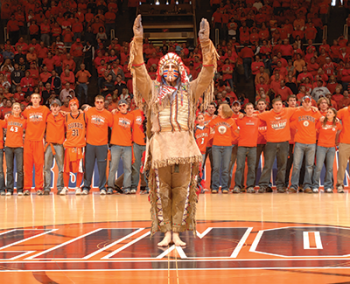Exposure to Native American team mascots causes stereotyping of other ethnic groups
A study led by Chu Kim-Prieto suggests that one racial stereotype may enhance another, regardless of the race being depicted.


Redskins. Braves. Indians. These words call to mind any number of college, high-school, and professional sports brands—mythical Native American chieftains decked out in feathered headdresses, often looking fearsome and ready for battle.
When the NCAA banned a number of Native American-inspired images and team names from postseason tournaments in 2005, deeming them “hostile or abusive,” it set off a wave of protests that such traditions were harmless and in good faith.
But a new study led by Chu Kim-Prieto, assistant professor of psychology, supports the conclusion that such stereotypes do have a negative impact on viewers. More specifically, the suggests that one stereotype may enhance another, regardless of the race being depicted.
“As an empiricist, I wanted to better understand this issue, but realized that empirical evidence on this issue was scant,” she said.
Kim-Prieto hypothesized that such symbols could act as “primers,” instigating stereotypical thoughts in the minds of viewers without their knowing it.
She launched two surveys, one at TCNJ and one at her alma mater—the University of Illinois, former home of the NCAA-banned mascot Chief Illiniwek. In her study, Kim-Prieto tested to see if simply observing and reading about the Native American sports symbol would increase respondents’ prejudices about Asian-Americans, an unrelated racial group.
The first survey, completed by 79 students at University of Illinois, recorded the effects of a visual cue. Each participant was given a folder: one third of the folders were decorated with Chief Illinewek stickers; another third showed the letter “I,” a university athletic logo; and the last third were blank. The students were asked to read 25 statements based on Asian-American stereotypes, including, “Asian Americans tend to have less fun compared to other social groups,” and “Asian Americans are motivated to obtain too much power in our society.” Then, they registered their agreement or disagreement on a five-point scale.
In support of Kim-Prieto’s theory, the students who saw Chief Illiniwek reacted more positively to the negative Asian-American stereotypes than the others.
In a second experiment at TCNJ, 161 students read one of two short essays—a University of Illinois history of Chief Illiniwek and a description of the University’s arts center—and responded to the same list of statements.
Again, the respondents who were presented with a depiction of Chief Illiniwek agreed more with the stereotypes.
The effect of these depictions, while surprising, leaves something of a mystery. As with the graphic of Chief Illiniwek, there was nothing inherently negative in the essay describing him. Yet it still seems to have prompted the students, who were predominantly white, to react negatively toward another race.
“This is something that future studies will need to investigate,” Kim-Prieto acknowledged.
Her study nonetheless suggests something deep about racial consciousness, and she expects it will be used to elevate the public discussion on this and similar issues.
“I hope, as I would … with results of any other research, that people would be informed by research evidence when they engage in thoughtful conversations about the effects of various cultural symbols that we encounter in our society,” she said.
Kim-Prieto said that her work on stereotypes will continue and that she is “currently analyzing data that looks at other variables, such as helping behavior, aggression, as well as tendency to stereotype other groups of people.”
Posted on October 27, 2010

